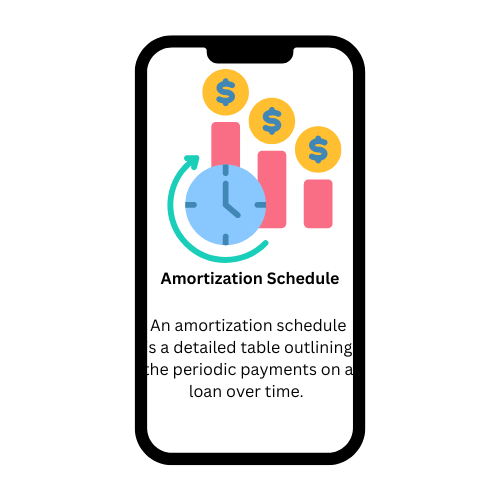An amortization schedule is a detailed table outlining the periodic payments on a loan over time. It shows how each payment is split between the interest and the principal, leading to the gradual reduction of the loan balance until it is fully paid off. Here’s a detailed explanation and example of how to create and interpret an amortization schedule.
Components of an Amortization Schedule
- Payment Number: The sequence number of each payment.
- Payment Date: The date on which the payment is due.
- Beginning Balance: The loan balance before the payment is made.
- Payment Amount: The total amount paid in each period.
- Interest Portion: The portion of the payment that goes toward interest.
- Principal Portion: The portion of the payment that goes toward reducing the principal.
- Ending Balance: The loan balance after the payment is made.
How It Works
- Fixed Monthly Payment: Each payment is the same throughout the loan term, providing predictability for budgeting.
- Interest Calculation: Interest is calculated on the remaining principal balance, so it decreases over time as the balance reduces.
- Principal Repayment: The portion of each payment that goes toward the principal increases over time, accelerating the payoff of the loan.
- Reducing Balance: The outstanding balance decreases with each payment, eventually reaching zero at the end of the loan term
Components of an Amortization Schedule
An amortization schedule is a detailed table outlining the periodic loan payments over the life of a loan. Each payment is divided between interest and principal repayment, showing how the loan balance decreases over time. The key components of an amortization schedule are:
- Payment Number: This indicates the sequence of payments from the start to the end of the loan term.
- Payment Date: The specific date on which each payment is due.
- Payment Amount: The total amount paid in each period, typically remaining constant for fixed-rate loans.
- Interest Payment: The portion of each payment that goes towards paying the interest on the loan.
- Principal Payment: The portion of each payment that goes towards reducing the principal balance of the loan.
- Remaining Balance: The outstanding balance of the loan after each payment has been made.
- Cumulative Interest: The total amount of interest paid up to each payment date.
Importance of Amortization Schedule
An amortization schedule is an essential financial tool for both lenders and borrowers. Here are the key reasons why it is important:
For Borrowers:
- Understanding Payment Structure:
- Breakdown of Payments: An amortization schedule shows the exact allocation of each payment between interest and principal. This helps borrowers understand how much of their payment is reducing the loan balance versus paying interest.
- Financial Planning:
- Budgeting: Knowing the amount and frequency of loan payments helps borrowers plan their finances and manage cash flow effectively.
- Long-Term Planning: It provides a clear picture of when the loan will be fully paid off, aiding in long-term financial planning.
- Interest Savings:
- Prepayment Insights: The schedule shows the impact of making extra payments. Borrowers can see how additional payments reduce the principal faster and decrease total interest paid over the life of the loan.
- Transparency:
- Clear Expectations: It sets clear expectations about payment amounts and the loan payoff timeline, reducing confusion and misunderstandings.
- Verification: Borrowers can verify that the lender is applying payments correctly, ensuring accurate accounting and preventing potential errors or discrepancies.
For Lenders:
- Loan Management:
- Tracking Payments: Lenders use amortization schedules to track and manage loan payments, ensuring that each payment is correctly allocated to interest and principal.
- Interest Income Projection:
- Revenue Planning: It helps lenders project interest income over the loan term, aiding in financial planning and revenue forecasting.
- Compliance and Documentation:
- Regulatory Requirements: Many jurisdictions require lenders to provide borrowers with an amortization schedule as part of the loan documentation. It ensures compliance with legal and regulatory standards.
- Record-Keeping: It serves as an official record of the loan terms and payment history, useful for both parties in case of disputes or audits.
For Both Parties:
- Transparency and Trust:
- Clear Communication: It fosters transparency between borrowers and lenders, building trust and reducing potential conflicts.
- Dispute Resolution: In case of discrepancies or disputes, an amortization schedule serves as a reference point to resolve issues efficiently.
- Financial Decision-Making:
- Informed Choices: Both parties can make informed decisions regarding refinancing, loan modifications, or prepayments by understanding the detailed payment structure and remaining balance.
Applications of Amortization Schedule
Amortization schedules have a wide range of applications across various financial and business contexts. Here are some key applications:
- Personal Finance:
- Mortgage Loans: Homebuyers use amortization schedules to understand their monthly mortgage payments, track the reduction of their loan balance, and plan for prepayments to save on interest.
- Auto Loans: Car buyers can use amortization schedules to see how their monthly payments are divided between principal and interest and to plan for paying off their auto loan early.
- Student Loans: Borrowers can use these schedules to manage their student loan repayments, understand the impact of extra payments, and plan for loan forgiveness programs.
- Business Finance:
- Business Loans: Businesses use amortization schedules to manage loans taken for expansion, equipment purchases, or other investments, helping them plan cash flow and budget accordingly.
- Equipment Financing: Companies financing equipment purchases use these schedules to track their payments and manage their balance sheets.
- Commercial Real Estate Loans: Investors and businesses in commercial real estate use amortization schedules to manage property loans, project future expenses, and optimize their investment strategies.
- Accounting and Financial Reporting:
- Loan Accounting: Companies use amortization schedules to accurately record interest expenses and principal repayments in their financial statements.
- Depreciation and Amortization: While not the same as loan amortization, schedules are also used to systematically allocate the cost of intangible assets (like patents) and tangible assets (like machinery) over their useful lives.
- Financial Planning and Analysis:
- Cash Flow Forecasting: Amortization schedules help individuals and businesses forecast future cash flows, aiding in financial planning and analysis.
- Debt Management: They are essential tools for managing and planning debt repayments, helping to optimize the debt structure and minimize interest costs.
- Legal and Compliance:
- Regulatory Requirements: Many financial institutions are required to provide amortization schedules as part of loan agreements to ensure transparency and compliance with regulations.
- Dispute Resolution: Amortization schedules can be used to resolve disputes over loan repayments by providing a clear record of how payments are applied.
- Investment Analysis:
- Real Estate Investments: Real estate investors use amortization schedules to analyze the impact of mortgage payments on cash flow and to plan investment strategies.
- Bond Amortization: Investors in amortizing bonds (like mortgage-backed securities) use these schedules to understand the repayment structure and predict cash flows.
- Education and Training:
- Financial Literacy: Amortization schedules are often used in educational contexts to teach students and consumers about loans, interest rates, and debt management.
- Professional Training: Financial professionals use these schedules in training programs to enhance their understanding of loan structures and financial planning.
Calculating Amortization Schedule
- Determine the Monthly Payment: The monthly payment can be calculated using the formula:
M=P r(1+r)n /(1+r)n-1
- where:
- M is the monthly payment
- P is the principal loan amount
- r is the monthly interest rate (annual rate divided by 12)
- n is the total number of payments (loan term in years multiplied by 12)
- Create the Schedule:
For each month, calculate:
- Interest payment: Interest Payment=Remaining Balance × r
- Principal payment: Principal Payment=M−Interest Payment
- Remaining balance: Remaining Balance=Previous Balance−Principal Payment
Example Of Amortization Schedule
Let’s say you have a loan of ₹1,000,000 (1 million rupees) at an annual interest rate of 6% for a term of 5 years (60 months).
Calculate Monthly Payment:
- Principal (PPP) = ₹1,000,000
- Annual interest rate = 6%
- Monthly interest rate (r) = 6% / 12 = 0.5% = 0.005
- Total number of payments (n) = 5 years * 12 = 60
M= 1,000,000(1+0.005)60
(1+0.005)60-1
The monthly payment (MMM) for the loan is approximately ₹19,332.80.
Amortization Schedule Calculation
We’ll calculate the interest payment, principal payment, and remaining balance for each month.
Here is a sample calculation for the first few months:
Month 1:
- Interest Payment = ₹1,000,000 * 0.005 = ₹5,000
- Principal Payment = ₹19,332.80 – ₹5,000 = ₹14,332.80
- Remaining Balance = ₹1,000,000 – ₹14,332.80 = ₹985,667.20
Month 2:
- Interest Payment = ₹985,667.20 * 0.005 = ₹4,928.34
- Principal Payment = ₹19,332.80 – ₹4,928.34 = ₹14,404.46
- Remaining Balance = ₹985,667.20 – ₹14,404.46 = ₹971,262.74
Here’s the beginning of the amortization schedule for a ₹1,000,000 loan at a 6% annual interest rate over 5 years (60 months):
Payment Number | Payment Amount | Interest Payment | Principal Payment | Remaining Balance | Cumulative Interest |
1 | ₹19,332.80 | ₹5,000.00 | ₹14,332.80 | ₹985,667.20 | ₹5,000.00 |
2 | ₹19,332.80 | ₹4,928.34 | ₹14,404.47 | ₹971,262.73 | ₹9,928.34 |
3 | ₹19,332.80 | ₹4,856.31 | ₹14,476.49 | ₹956,786.25 | ₹14,784.65 |
4 | ₹19,332.80 | ₹4,783.93 | ₹14,548.87 | ₹942,237.37 | ₹19,568.58 |
5 | ₹19,332.80 | ₹4,711.19 | ₹14,621.61 | ₹927,615.76 | ₹24,279.77 |
- This schedule shows the breakdown of each payment into interest and principal, the remaining balance after each payment, and the cumulative interest paid so far. One can continue this process for the entire loan term to complete the full amortization schedule.
Difference Between Fixed And Adjustable-Rate Amortization Schedules
The primary difference between fixed-rate and adjustable-rate amortization schedules lies in how the interest rate is applied and how the payments are calculated over the life of the loan. Here are the key differences:
Fixed-Rate Amortization Schedule:
- Interest Rate:
- The interest rate remains constant throughout the loan term.
- Monthly Payments:
- The monthly payment amount remains the same over the life of the loan.
- Predictability:
- Borrowers can predict their payments and plan their budgets more effectively since the payment amount does not change.
- Amortization Calculation:
- The principal and interest portions of each payment are calculated based on a fixed rate. Initially, a larger portion of the payment goes towards interest, but over time, the principal portion increases.
Example:
For a ₹1,000,000 loan at a 6% fixed annual interest rate over 5 years, the monthly payment remains ₹19,332.80, and the interest portion decreases while the principal portion increases over time.
Adjustable-Rate Amortization Schedule:
- Interest Rate:
- The interest rate can change periodically based on an index rate or benchmark (e.g., LIBOR, prime rate).
- There is usually an initial fixed-rate period, after which the rate adjusts periodically (e.g., annually).
- Monthly Payments:
- The monthly payment amount can change when the interest rate adjusts.
- Adjustments and Caps:
- Adjustable-rate mortgages (ARMs) typically have rate caps that limit how much the interest rate and/or payment can increase at each adjustment period and over the life of the loan.
- Uncertainty:
- Borrowers face uncertainty regarding future payment amounts. Payments can increase or decrease based on interest rate changes.
- Amortization Calculation:
- Initially, the schedule is calculated based on the initial fixed rate. When the rate adjusts, the schedule is recalculated based on the new rate, affecting the payment amounts and the allocation between principal and interest.
Example:
For a ₹1,000,000 loan with an initial 6% interest rate for 5 years that adjusts annually, the initial payments are calculated at the 6% rate. After the adjustment period, if the rate increases to 7%, the new payments are calculated based on the remaining balance and the new rate, resulting in higher payments.
Summary of Differences:
Aspect | Fixed-Rate Amortization | Adjustable-Rate Amortization |
Interest Rate | Constant throughout the loan term | Varies based on an index rate/benchmark |
Monthly Payments | Fixed payments | Variable payments, adjusting periodically |
Predictability | High predictability | Less predictability due to rate changes |
Initial Period | No specific initial period | Often has an initial fixed-rate period |
Rate Adjustments | None | Periodic adjustments, typically annually |
Caps on Adjustments | Not applicable | Caps on rate/payment changes are common |
Payment Structure | Fixed schedule with decreasing interest | Variable schedule recalculated on rate changes |
Impact on Borrowers:
- Fixed-Rate Loans: Suitable for borrowers who prefer stability and predictability in their payments. They can budget more effectively and are not affected by interest rate fluctuations.
- Adjustable-Rate Loans: May offer lower initial rates and payments, which can be beneficial for borrowers planning to sell or refinance before the adjustment period. However, they carry the risk of higher payments if interest rates rise.
Conclusion
Thus An amortization schedule is a detailed table outlining the periodic loan payments over the life of a loan. Each payment is divided between interest and principal repayment, showing how the loan balance decreases over time.




